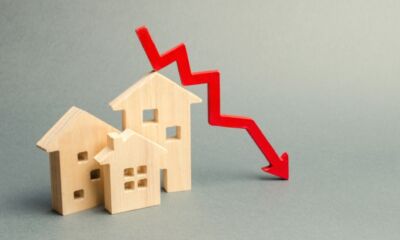What is negative equity?
If you own a property with a home loan attached to it, you may have heard of the term ‘negative equity’. So what is negative equity, what causes it and how can you minimise it?

If you own a property with a home loan attached to it, you may have heard of the term ‘negative equity’. So what is negative equity, what causes it and how can you minimise it?
KEY POINTS
- Very few borrowers currently have negative equity in their properties in Australia, but it can still occur.
- Factors like buying during the peak of the market cycle, overpaying for a home, having a low loan-to-value ratio and/or overcapitalisation may lead to negative equity.
- Having negative equity doesn’t always mean you’re in financial trouble, unless you are forced to sell your property.
What is negative equity?
Negative equity is when the market value of your property is lower than the balance remaining on your home loan.
For example, say you purchase a home for $800,000 with a 10% deposit, pay lenders mortgage insurance (LMI) on the loan and make interest-only mortgage payments, your mortgage would be about $735,000. However, if the value of your property was reduced by 10%, it would be worth $720,000, which is less than the mortgage, putting you into negative equity.
That said, being in negative equity doesn’t necessarily mean you’re in financial trouble, as the market may even out over time suggests big four bank Westpac. This is unless you are forced to sell the property.
While the Reserve Bank of Australia (RBA) says that very few borrowers are currently in negative equity on their mortgages, there are some circumstances which can cause negative equity for Australian homeowners.
Most commonly, it can occur when a buyer has paid above the market value for a property or bought in a location with a history of turbulent property prices, such as towns reliant on business or large scale projects (e.g. mining towns).
An example of this can be seen in Moranbah, Queensland, which had median house prices of $750,000 during the town’s boom that later fell to below $200,000 when circumstances changed, says real estate analysis website Hotspotting by Ryder. Prices managed to somewhat recover, but are still less than half of that $750,000 peak.
What factors can cause negative equity?
There are a number of other factors which may lead to having negative equity in a property, including:
Buying at the peak of the cycle
Negative equity may occur if a property was bought at the peak of a market. Market cycles have periods of growth and contraction, and buying at the peak can result in a property decreasing in value for a period of time.
Overpaying for the home
Sometimes homebuyers can end up overpaying for a home—especially if they’ve become infatuated with the property and/or are in a competitive environment like an auction. If you pay too much for a property, you will usually start behind when it comes to potential capital growth.
High loan-to-value ratio
Purchasing property with a small deposit can potentially result in negative equity. If a borrower purchases a property with a 95% loan-to-value ratio (LVR) (a 5% deposit), for example, they only have a small ‘buffer’ against market prices. If the market drops, their loan could be larger in value than their property.
Overcapitalisation
Overcapitalisation usually occurs when a borrower attempts a renovation on a property that ends up costing more than the value it brings. For example, if a borrower increases their home loan by $100,000 to complete a renovation, but the value of the home increases by less than this amount, they have overcapitalised.
This can result in the property being worth less than their loan. Likewise, if the renovation is not completed because they have run out of funds, properties often have to be sold as is, making negative equity a real possibility.
Is there a type of property more susceptible to negative equity?
Brand new properties, especially new units, can bring a higher risk of negative equity because they may be priced at a premium, with the cost including developer and sales agent commissions.
Some new unit developments tend to attract property investors, rather than owner occupiers. An oversupply of investor-grade new units can impact property price growth and may result in negative equity. This issue could be a problem for buyers who have bought a new property to take advantage of the first home buyer grant and paid a premium price for it.
Similarly, an increase in the supply of a certain type of property, such as townhouses, for example, can cause a lowering of the price for similar new properties. Increased supply often decreases demand. Oversupply of any type of property in a particular area can increase the likelihood of borrowers going into negative equity.
Why can negative equity be a problem?
Generally speaking, negative equity is only a problem if you need to sell or refinance a property or use it as security for another loan. If you need to sell for financial reasons, and the loan is larger than the price you received, you may have an outstanding debt to the lender.
Likewise, if a property has negative equity, it can be difficult to refinance to a new lender. This is because lenders generally will not take on borrowers who have mortgages larger than the value of their properties. Because negative equity only really exists in theory until you sell the property, there should not be any impact on your credit score.
If you’re interested in your credit score, you can check it for free with Canstar or via the Canstar App.
How can you reduce the impact of negative equity on your property?
If you can make the repayments on a principal and interest home loan, equity in your property should generally improve over time. Also, as mentioned above, the property market moves in cycles, which could lead to your property gaining value over time.
Other options that may help reduce negative equity include:
- Considering renovations: If you can afford to renovate your property with your savings, this may help to improve its value, especially if you can do so without taking on more debt. It could be a good idea to speak with a valuer, such as a real estate agent, about any work you have planned to determine whether it will offer a return on your investment.
- Making more mortgage repayments: Borrowers may also choose to make extra or increased mortgage repayments to pay down home loans faster. This is usually available on variable rate home loans and those with redraw facilities. You could also consider making home loan repayments more frequently, such as fortnightly rather than monthly, as this may help you repay your mortgage faster and with less associated interest—improving your equity position.
- Avoid taking financial risks: If you have negative equity, it may be a wise idea to reduce your financial risk taking, such as avoiding taking on more debt or investing in highly volatile markets, and consolidate your financial position. If you still want to build wealth, you could consider investing in lower risk shares, managed funds and ETFs.
- Talking with your lender or mortgage broker: You can talk with your lender or mortgage broker to learn if you can refinance your loan to a better interest rate, which will reduce your mortgage repayments. This is especially important for people who may be experiencing financial hardship.
If you can get a lower interest rate and can afford to continue payments at the higher amount that you were paying before, you will pay off more of the principal in a shorter period of time, increasing your equity as a result. Keep in mind, however, that having negative equity could decrease your bargaining power when asking for a lower interest rate.
You should always consider your finances and personal circumstances when considering your financial options. Obtaining professional financial advice in these situations is strongly recommended.
Are there ways to help avoid negative equity?
One of the most effective ways to avoid negative equity in the future is to ensure you are not overpaying for a property.
Before purchasing any property, whether established or new, it can be worth understanding its current fair value on the market before buying. This can be achieved by ordering a property valuation or conducting research on recent comparable property sales in the local area, as well as planned developments. Major development and infrastructure changes, such as if a new highway is planned to run directly past the property or a new hospital or university is being built nearby, are likely to affect its price.
Another way to reduce the likelihood of negative equity is to improve the LVR by having a larger deposit relative to the purchase price.
If you have negative equity in your property, it’s recommended you seek appropriate professional advice. This can help you consider whether you should sell the property, do any of the above options or hold onto the property until the market improves in the area. Speaking with a financial counsellor or adviser may also help you determine the best strategy for your individual circumstances. The most important thing is not to panic. If you can make it through the situation while keeping your property, negative equity may be fixed over time.
The comparison rate for all home loans and loans secured against real property are based on secured credit of $150,000 and a term of 25 years.
^WARNING: This comparison rate is true only for the examples given and may not include all fees and charges. Different terms, fees or other loan amounts might result in a different comparison rate.

Up to $4,000 when you take out a IMB home loan. Minimum loan amounts and LVR restrictions apply. Offer available until further notice. See provider website for full details. Exclusions, terms and conditions apply.
 Owner occupied
Owner occupied
 20% min deposit
20% min deposit
 Redraw facility
Redraw facility
 Owner occupied
Owner occupied
 20% min deposit
20% min deposit
 Redraw facility
Redraw facility
 Owner occupied
Owner occupied
 10% min deposit
10% min deposit
 Redraw facility
Redraw facility
 Owner occupied
Owner occupied
 20% min deposit
20% min deposit
 Redraw facility
Redraw facility
 Owner occupied
Owner occupied
 20% min deposit
20% min deposit
 Redraw facility
Redraw facility
 Owner occupied
Owner occupied
 40% min deposit
40% min deposit
 Redraw facility
Redraw facility
 Owner occupied
Owner occupied
 40% min deposit
40% min deposit
 Redraw facility
Redraw facility
Canstar may earn a fee for referrals from its website tables, and from Sponsorship or Promotion of certain products. Fees payable by product providers for referrals and Sponsorship or Promotion may vary between providers, website position, and revenue model. Sponsorship or Promotion fees may be higher than referral fees. Sponsored or Promoted products are clearly disclosed as such on website pages. They may appear in a number of areas of the website such as in comparison tables, on hub pages and in articles. Sponsored or Promoted products may be displayed in a fixed position in a table, regardless of the product’s rating, price or other attributes. The table position of a Sponsored or Promoted product does not indicate any ranking or rating by Canstar. For more information please see How We Get Paid.
Cover image source: Andrii Yalanskyi/Shutterstock.com
This article was reviewed by our Finance Editor Jessica Pridmore before it was updated, as part of our fact-checking process.

The comparison rate for all home loans and loans secured against real property are based on secured credit of $150,000 and a term of 25 years.
^WARNING: This comparison rate is true only for the examples given and may not include all fees and charges. Different terms, fees or other loan amounts might result in a different comparison rate.
 Owner occupied
Owner occupied
 10% min deposit
10% min deposit
 Redraw facility
Redraw facility
Try our Home Loans comparison tool to instantly compare Canstar expert rated options.
The comparison rate for all home loans and loans secured against real property are based on secured credit of $150,000 and a term of 25 years.
^WARNING: This comparison rate is true only for the examples given and may not include all fees and charges. Different terms, fees or other loan amounts might result in a different comparison rate.






